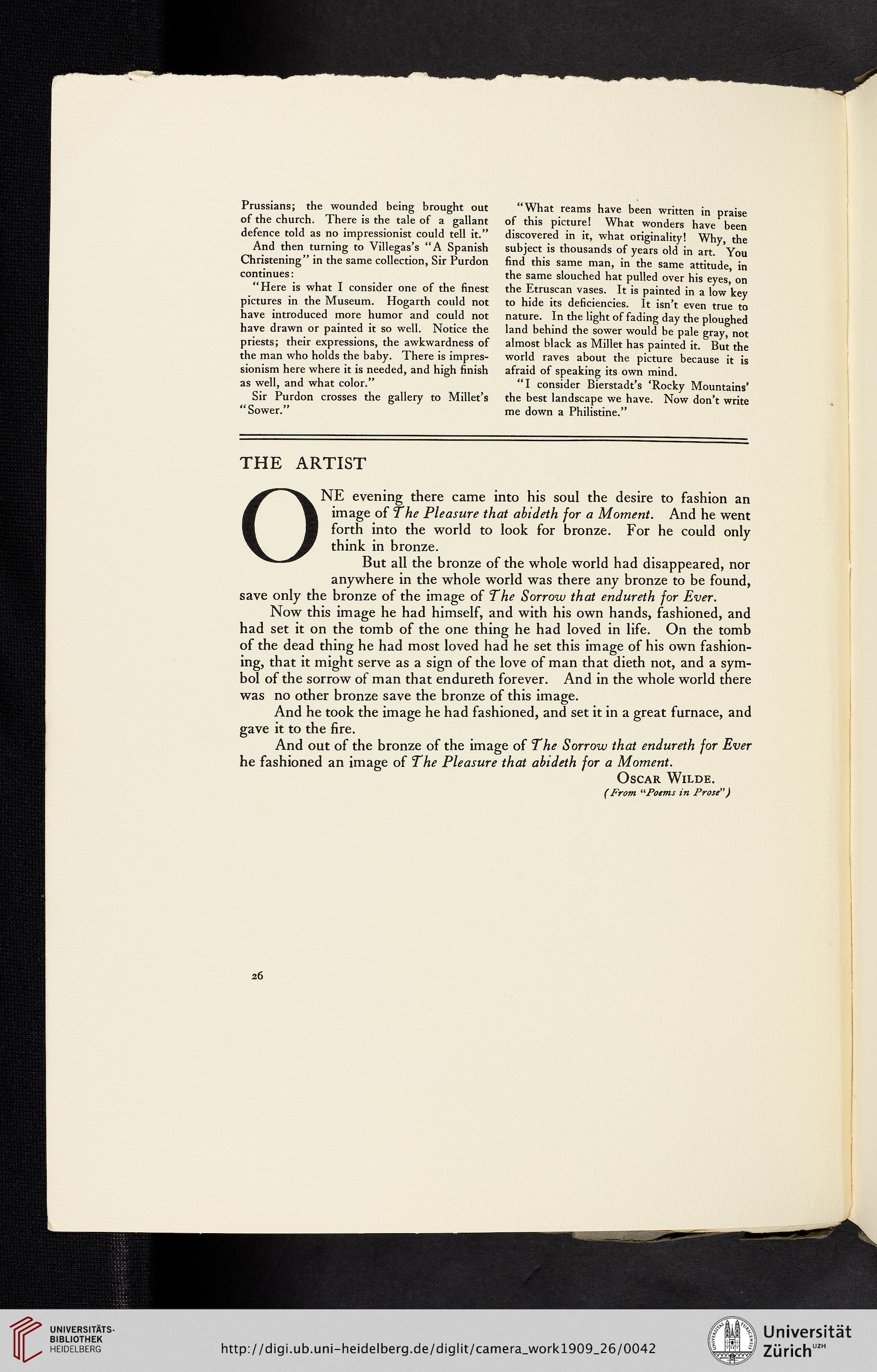Für diese Seite ist auch eine manuell angefertigte Transkription bzw. Edition verfügbar. Bitte wechseln Sie dafür zum Reiter "Transkription" oder "Edition".
Prussians; the wounded being brought out
of the church. There is the tale of a gallant
defence told as no impressionist could tell it.”
And then turning to Villegas’s “A Spanish
Christening” in the same collection, Sir Purdon
continues:
“Here is what I consider one of the finest
pictures in the Museum. Hogarth could not
have introduced more humor and could not
have drawn or painted it so well. Notice the
priests; their expressions, the awkwardness of
the man who holds the baby. There is impres-
sionism here where it is needed, and high finish
as well, and what color.”
Sir Purdon crosses the gallery to Millet’s
“Sower.”
“What reams have been written in praise
of this picture! What wonders have been
discovered in it, what originality! Why, the
subject is thousands of years old in art. You
find this same man, in the same attitude, in
the same slouched hat pulled over his eyes, on
the Etruscan vases. It is painted in a low key
to hide its deficiencies. It isn’t even true to
nature. In the light of fading day the ploughed
land behind the sower would be pale gray, not
almost black as Millet has painted it. But the
world raves about the picture because it is
afraid of speaking its own mind.
“I consider Bierstadt’s ‘Rocky Mountains'
the best landscape we have. Now don’t write
me down a Philistine.”
THE ARTIST
ONE evening there came into his soul the desire to fashion an
image of The Pleasure that ahideth for a Moment. And he went
forth into the world to look for bronze. For he could only
think in bronze.
But all the bronze of the whole world had disappeared, nor
anywhere in the whole world was there any bronze to be found,
save only the bronze of the image of The Sorrow that endureth for Ever.
Now this image he had himself, and with his own hands, fashioned, and
had set it on the tomb of the one thing he had loved in life. On the tomb
of the dead thing he had most loved had he set this image of his own fashion-
ing, that it might serve as a sign of the love of man that dieth not, and a sym-
bol of the sorrow of man that endureth forever. And in the whole world there
was no other bronze save the bronze of this image.
And he took the image he had fashioned, and set it in a great furnace, and
gave it to the fire.
And out of the bronze of the image of The Sorrow that endureth for Ever
he fashioned an image of The Pleasure that abideth for a Moment.
Oscar Wilde.
(From “Poems in Prose'*)
26
of the church. There is the tale of a gallant
defence told as no impressionist could tell it.”
And then turning to Villegas’s “A Spanish
Christening” in the same collection, Sir Purdon
continues:
“Here is what I consider one of the finest
pictures in the Museum. Hogarth could not
have introduced more humor and could not
have drawn or painted it so well. Notice the
priests; their expressions, the awkwardness of
the man who holds the baby. There is impres-
sionism here where it is needed, and high finish
as well, and what color.”
Sir Purdon crosses the gallery to Millet’s
“Sower.”
“What reams have been written in praise
of this picture! What wonders have been
discovered in it, what originality! Why, the
subject is thousands of years old in art. You
find this same man, in the same attitude, in
the same slouched hat pulled over his eyes, on
the Etruscan vases. It is painted in a low key
to hide its deficiencies. It isn’t even true to
nature. In the light of fading day the ploughed
land behind the sower would be pale gray, not
almost black as Millet has painted it. But the
world raves about the picture because it is
afraid of speaking its own mind.
“I consider Bierstadt’s ‘Rocky Mountains'
the best landscape we have. Now don’t write
me down a Philistine.”
THE ARTIST
ONE evening there came into his soul the desire to fashion an
image of The Pleasure that ahideth for a Moment. And he went
forth into the world to look for bronze. For he could only
think in bronze.
But all the bronze of the whole world had disappeared, nor
anywhere in the whole world was there any bronze to be found,
save only the bronze of the image of The Sorrow that endureth for Ever.
Now this image he had himself, and with his own hands, fashioned, and
had set it on the tomb of the one thing he had loved in life. On the tomb
of the dead thing he had most loved had he set this image of his own fashion-
ing, that it might serve as a sign of the love of man that dieth not, and a sym-
bol of the sorrow of man that endureth forever. And in the whole world there
was no other bronze save the bronze of this image.
And he took the image he had fashioned, and set it in a great furnace, and
gave it to the fire.
And out of the bronze of the image of The Sorrow that endureth for Ever
he fashioned an image of The Pleasure that abideth for a Moment.
Oscar Wilde.
(From “Poems in Prose'*)
26



